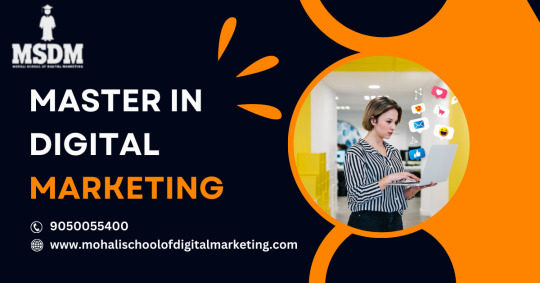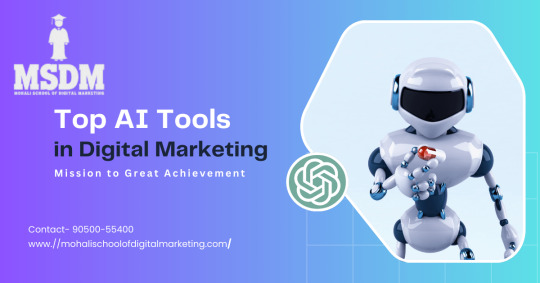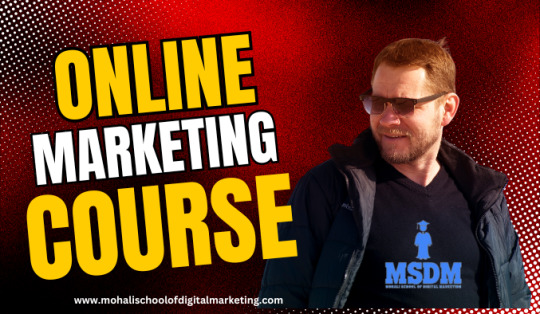Don't wanna be here? Send us removal request.
Text
Master in Digital Marketing: Essential Strategies for Growth

In the technologically advanced, fast-paced world of today, digital marketing has emerged as a key component of corporate strategy. As businesses increasingly turn to online platforms, the demand for experts in smart digital marketing continues to rise. A Master in Digital Marketing is more than just a credential; it’s a comprehensive path toward mastering the strategies that drive business success in the digital era.
Understanding the Master in Digital Marketing
Master’s students in digital marketing should expect to gain a thorough understanding of digital marketing tactics and tools. Numerous subjects are covered in this advanced degree, such as data analytics, social media tactics, SEO, content marketing, and more. Designed for professionals, business owners, and anyone seeking deeper digital marketing knowledge.
Key Components of a Master in Digital Marketing Program
1:Advanced Digital Strategies: Any master’s program in digital marketing must centre around sophisticated digital tactics. Master PPC, optimize email campaigns, and use automation to streamline marketing
2. Content Creation and Management: The king of internet marketing is content. Production of compelling, high-quality content that appeals to target audiences is frequently emphasised in programs. “Learn to write effective copy, create content calendars, and manage material across multiple channels to maintain brand consistency.”
3. Social Media Mastery: Social media, which has billions of users on sites like Facebook, Instagram, LinkedIn, and Twitter, is an essential part of digital marketing. A master’s in digital marketing enables you to create effective campaigns, engage with your audience, and optimize strategies using data.
Why Pursue a Master in Digital Marketing?
1.Enhanced Career Opportunities: Numerous professional pathways are accessible with a master’s degree in digital marketing. With this advanced degree, you can get the knowledge and qualifications you need to succeed in roles such as social media analyst, SEO specialist, content strategist, or manager of digital marketing.
2:Higher Earning Potential: Higher incomes in digital marketing often stem from advanced education, with master’s degree holders typically earning more than those with only an undergraduate degree. Investing in your education might yield significant financial rewards
3:Skill Diversification: A Master in Digital Marketing program’s comprehensive structure ensures that you will gain a wide range of skills. Mastering data analysis and content development empowers you to manage all aspects of digital marketing and transition smoothly into new roles.
Why Pursue a Master in Digital Marketing?
1:Artificial Intelligence and Machine Learning: Digital marketing is being revolutionised by AI and machine learning . Artificial Intelligence is vital in marketing, from chatbots for customer support to algorithms that personalize content. Professionals of the future will need to know how to use these tools to improve user experiences and produce outcomes.
2: Personalization and Customer Experience: Customization is crucial as customers demand personalized interactions and relevant information. With a Master in Digital Marketing, you’ll expertly use data to craft tailored strategies that exceed audience expectations and drive meaningful engagement
3:Video Content Dominance: Digital marketing is still dominated by video content. As TikTok and video storytelling grow, efficiently creating and sharing video content is becoming essential.
Conclusion
A complete approach to digital marketing is also fostered by the program’s emphasis on strategic thinking and data-driven decision-making, which equips students to take on challenging tasks and embrace new opportunities. . At Mohali School of Digital Marketing, our Master’s program blends rigorous training with real-world experience, empowering graduates to drive innovation and growth in a digital world.”
0 notes
Text
TOP AI TOOL IN DIGITAL MARKETING

1.Google Analytic 2.Chatbot 3.Dynamic Yield 4.Phrasee 5.DoubleClick by Google 6.Hootsuite 7.The Trade Desk
Google Analytics
Google analytics provide numerous benefits in digital marketing:-
1.It demonstrates the current activity on the website instantly. 2.Using audience insights it is able to understand demographics and interest of the users. 3.Helps to detect the way through which users reach your website. 4.Measure the success of your website in generating desired actions such as sign ups and transactions with conversion reports. 5.Track sales results, revenue, and product information if appropriate using e-commerce reporting. Overall its basic feature is cost free but for high-end features it requires a worthy subscription.
Chatbot
1.Chatbot enables the user-system interaction to be automated and easier. 2.Via text or speech interfaces, it can answer questions on the behalf of customers and provide information. 3.It can stimulate human conversation and improve operational efficiency and user experience on a variety of platforms. 4.It provides 24/7 customer support via immediate responses and handling common questions. 5. Chatbot provides a personalized market in the way of tailored recommendations and targeted offers. 6.Chatbot can help with meeting or appointment scheduling which eliminates the need for human coordination. It has a free version with basic functionality and limited features however, paid plans depend on complexity ,users volume and customization.
Dynamic Yield
1.It provides individualization via tailoring content to users’ preferences personally.
2.It allows continuous adjustment which facilitates users’ experience 3.Using dynamic field repetitive tasks can be automated which saves time and resources.
4.This AI tool additionally helps in targeting groups of people with relevant offers.
5.Delivers practical data and insights for making informed choices.
6.In order to find the best working strategy dynamic yield facilitates easy testing by way of A/B Testing.
7.Constantly it enhances conversion rates via targeted and personalized experience.Typically it calls for repeated subscription fees depending upon feature and scale,nevertheless it requires implementation costs for setup and integration.
Phrasee
1.Personalization can be achieved via sending messages to audience segments. 2.We can easily convince people which enhances engagement and interactions with persuasive language . 3.Through language testing it overall improves performance . 4.Enhances efficiency by the way of speeding content creation with AI generated copy.
0 notes
Text
BUILDING BRAND AUTHORITY
Introduction
In today’s competitive market, building brand authority is essential for establishing a trustworthy and credible presence. Brand authority goes beyond mere recognition; it’s about being perceived as an expert and leader in your industry. This comprehensive guide will explore the strategies and steps necessary to build and sustain brand authority effectively.
What is Brand Authority?
The degree of credibility and trust that a brand has gained from its audience and colleagues in the industry is referred to as brand authority. In contrast to brand awareness, which highlights customer familiarity with a brand, brand authority places emphasis on knowledge and power.
Why Brand Authority Matters:
Trust and Credibility: Brands with authority are trusted by consumers, leading to higher levels of engagement and loyalty.
Customer Loyalty and Retention: Customers are more likely to remain loyal to brands they perceive as authoritative.
SEO and Online Visibility: Search engines favor authoritative brands, improving organic rankings and visibility.
Understanding Your Brand
To build brand authority, you need a deep understanding of your brand identity and target audience.
Defining Your Brand Identity:
Core Values and Mission: Clearly define what your brand stands for and its mission .
Unique Selling Propositions (USPs): Identify what sets your brand apart from competitors.
Understanding Your Target Audience:
Demographics and Psychographics: Know your audience’s age, gender, income, lifestyle, and interests.
Pain Points and Needs: Understand the challenges and needs of your audience to tailor your message effectively.
Creating High-Quality Content
High-quality content is the cornerstone of building brand authority. It demonstrates your expertise and provides value to your audience.
Content Marketing Strategy:
Importance of Quality Over Quantity: Focus on producing well-researched, informative, and engaging content.
Types of Content: Utilize a mix of blogs, videos, infographics, podcasts, and social media posts.
Developing a Content Calendar:
Consistency and Frequency: Regular posting schedules help maintain audience engagement.
Seasonal and Evergreen Content: Balance timely content with content that remains relevant over time.
SEO Best Practices:
Keyword Research: Identify keywords relevant to your industry and incorporate them naturally into your content.
On-Page SEO: Optimize titles, meta descriptions, headers, and images. Link building: To increase authority, develop backlinks of the highest caliber from reliable sources.
Leveraging Social Media
Social networking sites are effective resources for increasing brand authority. They give you the chance to speak with your audience directly and present your knowledge.
Choosing the Right Platforms:
Audience Presence: Focus on platforms where your target audience is most active.
Platform Suitability: Choose platforms that align with your content type (e.g., Instagram for visuals, LinkedIn for professional content).
Engaging with Your Audience:
Regular posting; it ensures that your audience is informed and involved.
Interactive Content: Use polls, Q&A sessions, and live videos to interact with your audience.
Responding to Feedback: Engage with comments and messages to build relationships and trust.
Building Relationships and Networking
Building brand authority involves connecting with industry peers, influencers, and customers.
Networking with Industry Experts:
Collaborations and Partnerships: Partner with other authoritative brands or influencers to expand your reach .
Guest Blogging and Interviews: Contribute to reputable publications and participate in industry interviews.
Engaging with Customers:
Customer Reviews and Testimonials: Encourage satisfied customers to leave reviews and share testimonials.
Community Building: Create forums or groups where customers can interact and share their experiences.
Establishing Thought Leadership
Becoming a thought leader in your industry is a significant step towards building brand authority. It involves sharing unique insights, innovative ideas, and expert opinions.
Publishing Original Research and Insights:
Whitepapers and Ebooks: Create in-depth resources that provide valuable information to your audience.
Case Studies: Share success stories and detailed analyses of how your products or services have made a difference.
Speaking Engagements and Webinars:
Industry Conferences: Participate in conferences and panels to showcase your expertise.
Hosting Webinars: Conduct webinars on relevant topics to educate your audience and demonstrate authority.
Measuring and Adjusting Your Strategy
Building brand authority is an ongoing process that requires constant monitoring and adjustment.
Tracking Key Metrics:
Website Traffic and Engagement: Monitor page views, time on site, and bounce rates .
Social Media Metrics: Monitor likes, shares, comments, and the number of followers on social media.
SEO Performance: Analyze keyword rankings, organic traffic, and backlinks.
Adjusting Your Strategy:
Analyzing Data: Use analytics tools to understand what’s working and what’s not.
Continuous Improvement: Regularly update your strategy based on insights and feedback.
Case Studies of Successful Brand Authority Building
Examining real-world examples can provide valuable insights into effective brand authority building strategies.
Case Study 1: HubSpot
Content Marketing Mastery: HubSpot’s blog and resource library are filled with high-quality, actionable content.
Thought Leadership: Regularly publishes research and hosts industry events, solidifying its position as a marketing authority.
Case Study 2: Moz
SEO Expertise: Moz’s comprehensive guides, tools, and resources establish it as a leader in the SEO industry.
Community Engagement: Active community forums and contributions from industry experts enhance its authority.
Case Study 3: Patagonia
Brand Values: Patagonia’s commitment to environmental sustainability resonates with its audience.
Authentic Storytelling: Uses powerful narratives to connect with customers and build trust.
Conclusion
Building brand authority is a multifaceted process that involves understanding your brand and audience, creating high-quality content, leveraging social media, networking, establishing thought leadership, and continuously measuring and adjusting your strategy. By following these steps, you can position your brand as a trusted and credible leader in your industry, ultimately driving customer loyalty, retention, and growth.
0 notes
Text
ONLINE MARKETING COURSE

0 notes
Text
power of content marketing
n today’s digital age, where information is readily accessible and consumers are increasingly empowered, traditional marketing tactics are losing their effectiveness. Instead, businesses are turning to content marketing as a strategic approach to engage and educate their audiences. This shift reflects a deeper understanding of consumer behavior and the value of building long-term relationships through valuable content. In this blog post, we will explore the profound impact and strategic importance of content marketing in the modern business landscape.”Discover the power of content marketing! Learn how to create compelling content that engages your audience, boosts brand awareness
Understanding Content Marketing
Content marketing can be defined as the strategic creation and distribution of valuable, relevant, and consistent content to attract and retain a clearly defined audience — with the ultimate goal of driving profitable customer action. Unlike traditional advertising, which interrupts consumers, content marketing seeks to provide information or entertainment that customers voluntarily seek out and engage with.
Key Elements of Content Marketing:
Value-Driven Content: Content should provide genuine value to the audience, addressing their needs, concerns, or interests.
Audience-Centric Approach: Content is tailored to resonate with specific audience segments, based on demographics, interests, and behaviors.
Consistency and Frequency: Regular publishing of content builds trust and authority over time.
Multi-Channel Distribution: Content is distributed across various platforms such as websites, social media, email newsletters, and more.
Measurable Goals: Content marketing efforts should be aligned with specific business objectives, such as lead generation, brand awareness, or customer retention.
The Strategic Impact of Content Marketing
1. Building Brand Authority and Trust
High-quality content demonstrates expertise and authority within a particular industry or niche. By consistently delivering valuable insights, businesses can position themselves as thought leaders, earning the trust and respect of their audience. This trust is crucial for converting prospects into loyal customers and advocates for the brand.
2. Driving Organic Traffic and SEO Benefits
Search engines favor websites that regularly update their content with relevant and valuable information. Content marketing efforts, therefore, contribute to improved search engine rankings, driving organic traffic to the website. Well-optimized content with targeted keywords can attract qualified leads who are actively searching for solutions or information related to the business offerings.
3. Engaging and Nurturing Leads
Content marketing allows businesses to engage potential customers at different stages of the buyer’s journey. From awareness to consideration and decision-making, strategically crafted content can provide the information and reassurance needed to move leads closer to making a purchase decision. Content formats such as case studies, whitepapers, and comparison guides are particularly effective in addressing specific pain points and influencing buyer behavior.
4. Enhancing Customer Retention and Loyalty
Content marketing doesn’t end after a sale is made. Continued engagement through relevant content keeps customers informed and satisfied, fostering long-term relationships. Regular updates, tips, and educational content demonstrate ongoing value, encouraging repeat purchases and turning customers into brand advocates.
5. Cost-Effectiveness and Long-Term ROI
Compared to traditional advertising, content marketing can deliver a higher return on investment (ROI) over time. While initial costs may include creating and distributing content, the long-term benefits — such as increased brand visibility, organic traffic, and customer loyalty — far outweigh the initial investment. Additionally, content remains accessible and discoverable online indefinitely, continuing to attract and engage audiences long after it’s published.
Implementing an Effective Content Marketing Strategy
1. Define Clear Objectives and Audience
Begin by identifying specific goals for your content marketing efforts. Whether it’s increasing website traffic, generating leads, or improving brand awareness, clear objectives will guide your content creation and distribution strategies. Similarly, define your target audience personas to ensure that your content resonates with their interests, challenges, and preferences.
2. Content Creation and Optimization
Develop a content calendar outlining topics, formats, and publication schedules aligned with your objectives and audience personas. Create content that addresses common pain points, offers solutions, or provides valuable insights. Optimize content for SEO by including relevant keywords, meta descriptions, and internal links to improve visibility and organic search rankings.
3. Distribution and Promotion
Utilize multiple channels to distribute and promote your content effectively. This includes social media platforms, email newsletters, guest blogging, and collaborations with influencers or industry experts. Tailor your distribution strategy to each platform’s audience and engagement preferences, maximizing reach and engagement.
4. Measure and Analyze Performance
Monitor key performance indicators (KPIs) such as website traffic, engagement metrics (likes, shares, comments), conversion rates, and ROI. Use analytics tools to track the effectiveness of your content marketing efforts and make data-driven adjustments to optimize future content strategies.
5. Iterate and Improve
Content marketing is an iterative process that requires continuous improvement based on insights gained from performance data and audience feedback. Regularly review and refine your content strategy, experiment with different formats and topics, and stay updated with industry trends to maintain relevance and effectiveness.
Case Studies: Success Stories in Content Marketing
To illustrate the power of content marketing in action, let’s examine a few notable case studies:
Red Bull: Known for its extreme sports content and high-energy brand image, Red Bull’s content marketing strategy focuses on creating engaging videos, articles, and events that resonate with its target audience of adventurous, young consumers.
HubSpot: As a leading provider of inbound marketing software, HubSpot has built its brand through extensive content creation, including blogs, eBooks, webinars, and guides that educate and empower marketers and business owners.
Blendtec’s “Will It Blend?”: Blendtec’s viral video series demonstrating the blender’s capabilities with unconventional items not only increased brand awareness but also drove significant sales growth by showcasing product features in an entertaining and memorable way.
The Future of Content Marketing
As consumer behaviors and technology continue to evolve, the future of content marketing holds exciting possibilities. Emerging trends such as interactive content (quizzes, polls, augmented reality), personalized experiences (AI-driven recommendations), and voice search optimization are reshaping how brands engage with audiences and deliver value.
In conclusion, content marketing represents more than just a marketing tactic — it’s a strategic approach to building meaningful connections with consumers, establishing thought leadership, and driving sustainable business growth. By consistently delivering valuable content that educates, entertains, and inspires, businesses can differentiate themselves in competitive markets and cultivate lasting relationships with their audience. Embrace the power of content marketing, and unlock its potential to transform your business in the digital age.
Remember, the key lies in understanding your audience, delivering valuable insights, and continually adapting your strategies based on data-driven insights. As you embark on your content marketing journey, prioritize authenticity, relevance, and consistency to maximize its impact and achieve your business objectives effectively. “Discover the power of content marketing! Learn how to create compelling content that engages your audience, boosts brand awareness
#digital marketing#ppc services#seo#social media#ppc marketing#content marketing strategy#content marketing services#content menu
1 note
·
View note